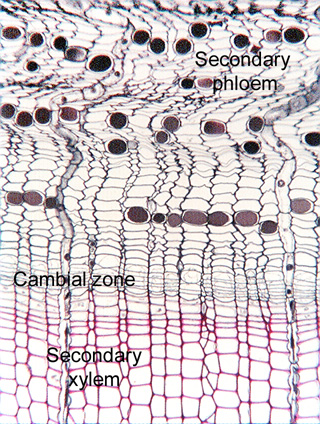 Fig. 6.1-3. Transverse
section through a woody stem of pine (Pinus). The gray material at the
top of the micrograph is the secondary phloem (part of the bark) and the red
material at the bottom is secondary xylem (wood). The several layers of thin,
flat gray cells between the two constitute the cambial zone, the region that
contains the vascular cambium. The vascular cambium produces both the secondary
phloem and secondary xylem; that is, it is located between the two tissues that
it produces. Although it is not a common verb, we could say the vascular cambium
is intercalated between the tissues it produces, it is an intercalary
meristem.
Fig. 6.1-3. Transverse
section through a woody stem of pine (Pinus). The gray material at the
top of the micrograph is the secondary phloem (part of the bark) and the red
material at the bottom is secondary xylem (wood). The several layers of thin,
flat gray cells between the two constitute the cambial zone, the region that
contains the vascular cambium. The vascular cambium produces both the secondary
phloem and secondary xylem; that is, it is located between the two tissues that
it produces. Although it is not a common verb, we could say the vascular cambium
is intercalated between the tissues it produces, it is an intercalary
meristem.